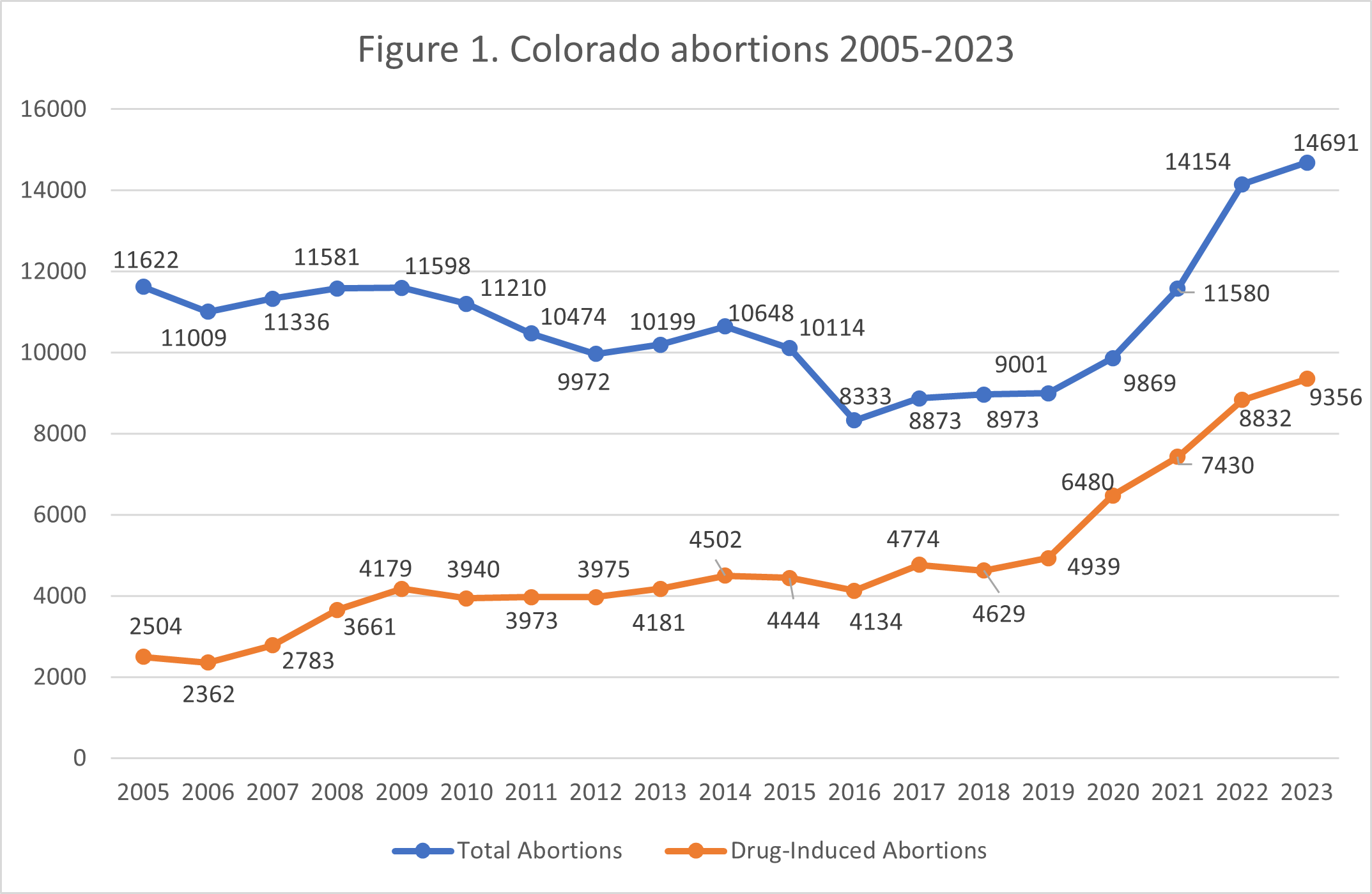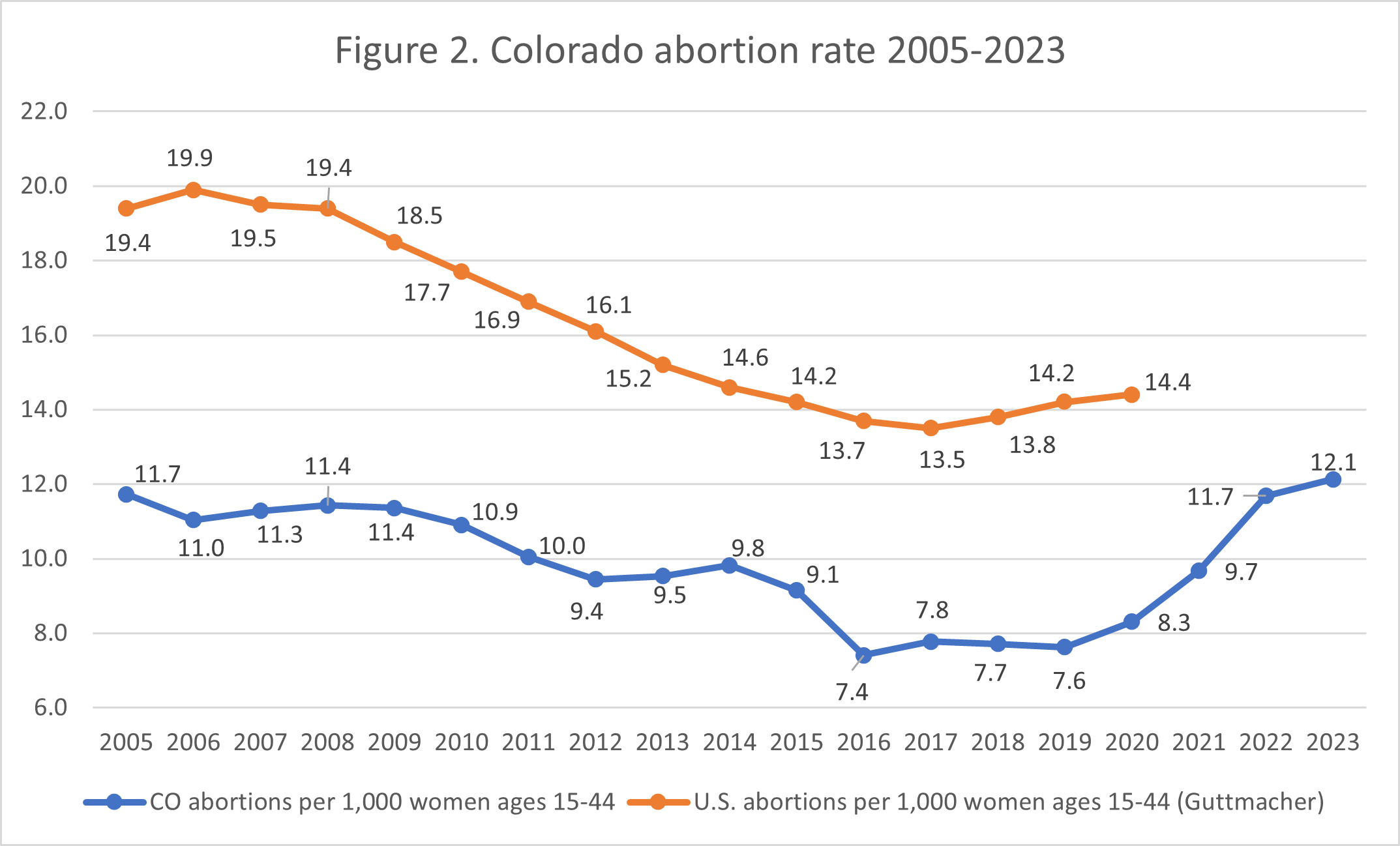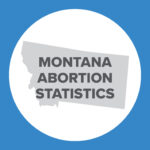Abortion Reporting: Colorado (2023)
Colorado’s 2023 abortion report was provided to Charlotte Lozier Institute (CLI) by the Colorado Department of Public Health and Environment (DPHE) upon request in May 2024. The report shows that abortions increased from 2022.
Statistics and Changes in Colorado Abortions, 2022-2023

Abortion Totals and Trends
There were 14,691 abortions in Colorado in 2023, up 4% from the previous year and the highest total reported in the state since 1985. Drug-induced abortions rose to 9,356 in 2023, an increase of 6% and constituting 64% of the total (Fig. 1). CLI estimates that Colorado’s state abortion rate was 12.1 abortions per 1,000 women ages 15 to 44, an increase of 4% from 2022 (Fig. 2).1 As of July 2024, 12 states have released 2023 abortion statistics, with five showing that abortions had increased from the previous year.
The Guttmacher Institute’s Monthly Abortion Provision Study estimated that more than 25,000 abortions occurred in Colorado in 2023, almost double the total that the state reported. One potential reason for this discrepancy is that Guttmacher’s study includes the number of drug-induced abortions that were prescribed via telemedicine and mailed to a patient in a state where abortion is still permitted. Colorado does not limit abortion at any gestational age, so it is possible that Guttmacher’s count for Colorado’s 2023 total included mail-order abortions prescribed by doctors in the United States and mailed into Colorado. When CLI asked the Colorado DPHE about this discrepancy, the Department said that their totals are reliant on forms provided to them directly from abortion providers in Colorado and could not speak to the reasons for the discrepancy.
The following analysis is based on the state’s data provided to CLI.
State Report Summary
In 2023, 71% of the abortions reported in Colorado were performed on state residents, while 29% were obtained by women from other states, including 19% on women from Texas. Not quite 1% of Colorado abortions were performed on women whose state of residence was not reported.
Ten percent of the abortions reported in Colorado were performed on girls under the age of 20, including 3% on girls under the age of 18. Thirty-one percent were obtained by women ages 20 to 24, and 28% were on women ages 25 to 29. Twenty-eight percent were performed on women in their thirties, and 3% were on women ages 40 and older.
The largest share of reported abortions were performed on non-Hispanic white women (43%). One percent were performed on white Hispanic women, and 12% were performed on black women; the report does not differentiate between abortions performed on Hispanic and non-Hispanic black women. Five percent of Colorado abortions were reportedly performed on women of other races. However, race was not reported for 39% of the abortions. Even though the number of black abortions was small compared to the number performed on non-Hispanic and Hispanic white women, the black abortion rate of 29.2 abortions per 1,000 women ages 15 to 44 was almost four times the non-Hispanic white abortion rate of 8.2.
Over three-quarters of Colorado abortions (77%) were performed on unmarried women. Fourteen percent were on married women, and 9% on women of unknown marital status. Seventy percent of Colorado abortions were performed on women who reported no previous abortions. A fifth were on women with one prior abortion, and 9% were on women with two or more previous abortions. Fifty-nine percent of the abortions were obtained by women with no living children, compared to 18% on women with one child and 23% on women with two or more children. The number of previous abortions and number of previous living children were reported for all but 0.3%.
Drug-induced abortions made up over two-thirds (64%) of all abortions reported in Colorado. One quarter were suction curettage procedures, and 3% were performed via dilation and evacuation. One intrauterine installation, one hysterectomy/hysterotomy, and one sharp curettage procedure were performed. Two percent of abortions were performed using other methods. Six percent of the abortions were performed using an unknown method.
The vast majority of Colorado abortions (98%) occurred in doctors’ offices. Just 0.1% were performed in hospitals. However, the type of facility was not reported for 2% of the abortions. Seventy-three percent of the abortions were performed at eight weeks of gestation or earlier. Twelve percent occurred between nine and 10 weeks of gestation, while 4% were performed between 11 and 12 weeks. Four percent were reported between 13 and 15 weeks, and another 4% were performed between 16 and 20 weeks of gestation. There were 468 abortions at 21 weeks of gestation or later. Of these, 137 abortions were performed at 28 weeks or later, an increase of 16% from 2022 when there were 118 abortions performed at or after 28 weeks. Abortions at 21 weeks or later composed over 3% of the total in 2023. Gestational age was not reported for 0.3% of Colorado abortions.
Legislative Changes
As previously reported by CLI, a Catholic health clinic sued the state’s Attorney General, the Colorado Medical Board, and the state’s Board of Nursing after Governor Polis signed SB 23-190 into law in April 2023. This bill would have made it illegal to offer the abortion reversal protocol to women who wished to halt a drug-induced abortion. In October 2023, after the law had been temporarily enjoined from being enforced, a district judge ruled that abortion pill reversal could not be banned and that the temporary injunction on the law was to remain.
State Ranking
In 2024, CLI published a paper reevaluating abortion reporting across the country, with Colorado ranking as tied for 31st place. As CLI has previously recommended, Colorado could work to enforce its reporting requirements and ensure that all abortions occurring in the state are properly recorded. Given that drug-induced abortion, which has a much higher complication rate than surgical abortion, has skyrocketed in the state, Colorado could also require healthcare providers and emergency rooms to report abortion complications that they treat.


- National rates were calculated by Guttmacher Institute. Colorado rates were calculated by CLI using the following formula: (total number of abortions performed in Colorado ÷ number of resident women ages 15-44 [based on most recent population estimates]) x 1,000. Rates may differ slightly from previous CLI articles due to revised population estimates. Population estimates were obtained from CDC WONDER. Estimates for 2005-2009 are intercensal estimates of the July 1 resident population. Estimates for 2010-2019 are Vintage 2020 postcensal estimates of the July 1 resident population. Estimates for 2020-2022 are Vintage 2022 postcensal estimates of the July 1 resident population. Estimates were produced by the U.S. Census Bureau and the National Center for Health Statistics. Rates for 2023 were calculated using the Vintage 2022 postcensal estimates because 2023 population estimates have not yet been released by the CDC.






























